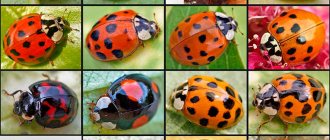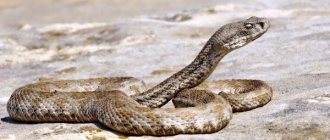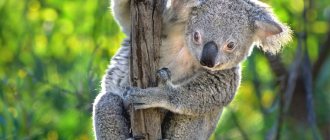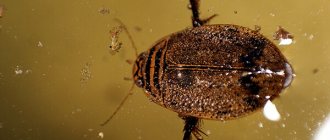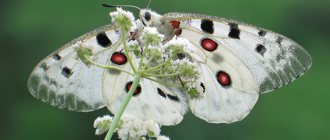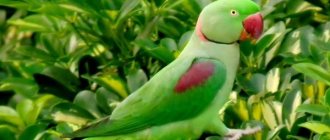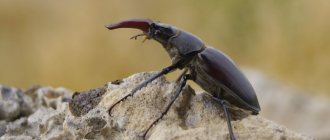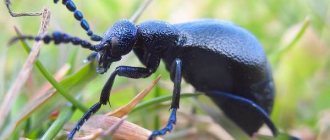Origin of the species and description
Photo: Ladybug
The ladybug is a very common ancient arthropod insect all over the world, a representative of the order Coleoptera and the ladybird family. This insect received its scientific name Coccinellidae due to its scarlet color. The bug lives almost everywhere. It was popularly nicknamed the ladybug because of the poisonous white liquid or “milk” that the insect secretes to scare away predators, and the ladybug because it helped in the fight against aphids and other pests to preserve the harvest, had a gentle disposition, and did not cause any harm to humans. .
Video: Ladybug
In Germany and Switzerland, the tiny insect is called St. Mary's bug, in South America - St. Anthony's ladybug. There were many legends about this little bug; it was said to have the ability to influence the weather.
Interesting fact: Even in ancient times, the Slavs considered the ladybug to be a heavenly creature, a messenger of the sun. That is why she was often called “Sunny”. It was forbidden to drive away the insect, so as not to incur bad luck. A bright bug that flew into a home brought blessings.
There are a huge number of varieties of ladybugs: the entire family has more than four thousand species, which in turn are divided into 7 subfamilies and 360 genera. The ladybug differs from other representatives of the family Coccinellidae in the structure of its legs. In the structure of each of them there are three visible and one hidden segment, so they seem to be three-component.
History of the name
If we consider the Latin name of the insect, in translation it means “scarlet”, which corresponds to the color of the bug. And the popular name appeared quite a long time ago due to sympathy for this insect. In Germany and Switzerland, the creature is called the “Virgin Mary’s bug”; in Slovenia and the Czech Republic, the insect is known as the “sun” (as many are accustomed to calling the ladybug in Russia). This creature also lives in Latin American countries, and they call it “St. Anthony’s bug.”
The origin of the domestic name ladybug is currently unknown. Some researchers believe that the bug received this name due to its ability to destroy aphids. Thus, a simple creature helps preserve huge crop plantations. It becomes clear what ladybugs eat.
Ladybug: description, structure, characteristics. What does a ladybug look like?
According to the biological classification, the ladybug is an arthropod insect that belongs to the Coleoptera and the family of ladybirds.
The size of a ladybug ranges from 4 to 10 mm. The shape of their body is either round or oval-elongated, flat below and very convex above. The body surface of some types of ladybugs is covered with fine hairs. The structure of their body includes a head, a pronotum, a chest consisting of three sections, an abdomen, wings with elytra and three pairs of paws.
The ladybug's head is small (although in some species it may be slightly elongated), it is motionlessly connected to the anterior chest. But the ladybug's eyes are relatively large. The insect's antennae, which consist of 8-11 segments, are highly flexible.
The ladybug's pronotum is convex, has a transverse structure and a notch at the anterior edge. On its surface there are often “signature” spots of different shapes.
Thanks to the presence of three pairs of paws, the ladybug can move quite quickly both on the grass and along plant stems. The abdomen of ladybugs consists of five or six segments, which are covered from below by sternites (segmental semirings).
Despite the fact that ladybugs have two pairs of wings, they fly only with the help of their two hind ones. The front wings, in the process of evolution, were transformed into hard elytra, which serve as protection for the hind wings at the moment when the ladybug is on the ground.
As a means of protection against predators, ladybugs are capable of secreting a kind of poisoned “milk” - cantharidin, a toxic yellow liquid that also has an unpleasant odor. Additionally, the bright colors of the ladybug scare away enemies. The color of the ladybug's protective covers can be not only bright red, but also yellow, black, white with spots of different colors and different configurations. Sometimes the pattern on the pronotum of a cow can indicate its gender.
Structural features
The sizes of these insects vary from four to ten millimeters. They have an elongated oval or round body with a strongly convex back. For those who do not know how ladybugs reproduce, it will be interesting that the surface of some species of these insects is covered with fine hairs.
The body of the beetles consists of a small head, pronotum, thorax, abdomen and wings with elytra. In addition, each individual has three pairs of legs. They use cantharidin as protection against predators. This poisonous, unpleasant-smelling yellow liquid repels birds and other potential enemies from insects.
Depending on the type of insect, its elytra can be brown, dark blue, black, bright yellow or deep red. Some of them have spots of different shades and configurations. Others have no patterns at all. And the seven-spotted ladybug is so named because it has seven spots on its back.
What does a ladybug eat?
Photo: Miraculous ladybug
The ladybug is a real predator among insects. Thanks to the structure of its jaw and the functioning of its digestive tract, it is able to hunt other insects and then quickly digest them. There are varieties that choose plant food: pollen, mold, flowers and leaves.
The diet of predatory species includes mainly:
- aphids in huge quantities;
- spider mites;
- caterpillars;
- insect larvae;
- butterfly eggs;
- some do not even disdain the larvae of Colorado beetles.
Ladybugs eat a lot, they are always hungry, especially their larvae. Each individual can easily destroy more than a hundred aphid larvae per day. Having large eyes, insects mainly use only their acute sense of smell in search of food.
The bugs do not hunt their victims, but only slowly, leisurely move through the foliage in search of food, and when they find a colony of aphids or a clutch of eggs of pests, they linger for a long time in this place for a meal until they destroy it completely. That is why the ladybug is a welcome guest on any personal plot, agricultural fields with crops, and in the garden. They are even specially bred at special enterprises and then distributed over cultivated lands with the help of agricultural aviation. Unfortunately, some varieties of these bugs, mainly living in Asia, cause damage to crops.
Now you know what ladybugs eat. Let's see how to breed these beautiful insects.
LiveInternetLiveInternet
The development of an insect with complete metamorphosis is characterized by the passage of four to five stages - eggs, larvae, pupae, adults, and sometimes prepupa. Using the LADYBUG as an example, it is interesting to observe all stages of insect development. Larvae with complete metamorphosis, as a rule, bear little resemblance to adult individuals, and therefore are called true larvae. Indeed, it is difficult to recognize an adult winged insect in a worm-like beetle larva or a butterfly caterpillar. You will see all the incredible transformations in these documentary photographs.[/td]
| Ladybug clutch. The beginning of an experiment on raising ladybugs at home. Gauze with a clutch of yellow, oval-shaped eggs is fixed on top under the incubator lid. In nature, the ladybug leaves eggs on the underside of the leaf. Seeing it, many take it for a plant disease and fight the affected leaves, destroying future beneficial insects, THE MOST IMPORTANT PROTECTORS of the crop! Larvae on the first birthday The appearance of ladybug larvae on the third day after laying eggs! This is a very fast maturation in a home incubator. I think this is due to the increased temperature. Cold air inhibits development in natural climatic conditions. At night and in cold weather, insects are immobilized, but in a warm, favorable state, activity increases. The egg clutch did not cool down at home during the abnormal Moscow heat; the larvae hatched and grew in a constant active life cycle of development. |
| ONE DAY OF LIFE and the first molt! One day and one night on a home farm accelerated development three times faster than in a natural habitat. The first moult on the second day of life from the moment of birth is a record short time. Having shed the skin of a newborn larva, the baby grew noticeably, acquired tubercles and tiny spots on its back, and in the first minutes its transparent legs amazingly transformed the entire appearance of the little cat. |
On the third day.
In the larval stage of development, ladybug babies are constantly on the move, searching for food.
An interesting fact is that insects do not see aphids, but stumble upon colonies of pests, gradually exploring one plant and moving on to another. The glutton larvae are active all day long, and on the third day they molt again and become half a centimeter long, which is five times longer than at the time of birth! On the seventh day of life,
after another molt, the chubby gluttons grew to one and a half centimeters in length, and the next day, having greatly increased in volume, they began to pupate.
| Ladybug larvae are the SECOND LIFE of insects! The most dangerous and active period of an insect’s life is in the larval stage of development. The absence of wings does not make it possible to escape from enemies; one has to rely on fast legs and camouflage coloring, and travel quite long distances in search of food. So the ability to hide will also come in handy. A difficult and dangerous period is accompanied by external changes in the larvae; during this time they molt several times. As a result, they grow twice as large as a real beetle. The photo shows the last day of the larval stage. In the incubator, over the course of a week, from millimeter-sized boogers, the glutton bugs grew more than a centimeter, which rarely happens in natural conditions due to lack of food. |
| Be careful! These are ladybird larvae. You won't immediately recognize the beetle in this appearance, but the red spots on the sides should attract attention. The larval stage of development of a ladybug is the exact opposite of its adult form, DO NOT CONFUSE these predators with PESTS! THESE ARE CROP DEFENDERS, an army of liquidators of aphids, psyllids, scale insects and mites. It also destroys the larvae of the Colorado potato beetle and other garden pests. During its life, one ladybug eats several thousand aphids. |
It is not difficult to imagine what invaluable help this beneficial insect can bring to gardeners. Be careful! TAKE CARE OF THEM! THESE ARE OUR HELPERS AND FRIENDS!
| LADYBUG PUPPE - THIRD LIFE! The ladybug pupa already resembles a real beetle in size and color! Having attached itself to the plants with its tail part, the insect larva is completely transformed. It does not die, it is quite alive, albeit motionless, but still active, a very complex internal life cycle of development! |
Ladybug pupa. The very beginning of birth. The first minutes of birth. Ladybug appears! “LIGHT BEETLE” is a seven-spotted RED LADYBUG. This is what it looks like in the very first minutes of life!!! A LIGHT or HOLY beetle in the mysterious and mysterious world of nature, in a new perfect guise, magically transformed and incredibly, miraculously changes its appearance before our eyes. Let's dry our NEW wings!
To dry its wings, the insect sits motionless for a long time, gradually straightening them, and then carefully folding them into a little bag and putting them away.
Mysterious moments of creation! The obvious is the incredible. On the border of GOOD and Evil, LIGHT and DARKNESS, FUTURE AND PAST, FAIRY-TALE AND REAL world. This is a NEWBORN SEVENTE-SPOTTED RED LADYBUG!
This is what she looks like in the first hours of her life: - yellow back and belly, - soft wings with barely visible spots. This is a wonderful and short-lived vision! And as the wings dry out, the color will change; within three hours it will take on its familiar appearance.
| NEWBORN LADYBUG IS A BIG BUG! The size of a newborn beetle is exactly the same as that of an adult insect. It is a mistake to think that little ladybugs are still babies, and then they will grow up and add spots on their backs over the years. A seven-spot ladybug will show all seven points from the first day; this is its species, not its age. If there was enough food in the larval stage of development, then the bug will be large, but if suddenly you saw a tiny ladybug, then it was simply starving! |
| The picture shows TWINS, with a slight time difference! The imago is an adult insect; within an hour, newborn yellow insects will develop spots on their soft, translucent wings; as the elytra dry out, they will become hard and turn red. And the next day, the stronger babies will be able to fly, but they will no longer grow, and the points will not increase over the years. The red seven-spotted ladybug changes color from yellow to red in the first hours after its appearance, spots appear, ALL seven spots at once! |
| Exactly 15 days passed from the start of the experiment to the day the ladybugs emerged. In the conditions of a home incubator, the development of insects accelerated three times. In a natural habitat, the entire development cycle with complete transformation will take one and a half months. So the Moscow abnormal heat gave an amazing result of the entire experiment. |
My ladybugs!
Among the Dutch, a ladybug landing on a hand or clothing is considered a good omen. The Czechs also believe that finding a cow will bring good luck, and the French believe that an amulet with its image protects children from misfortune and warns of danger. The name itself speaks about the role this insect played in the life of our ancestors. It was believed that the ladybug lives in heaven and only from time to time descends from heaven to convey the will of God to man. Many peoples believed that the gods themselves fed on its milk, so the ladybug could not be killed under any pretext. In English-speaking countries (England, Australia) the ladybug is called Ladybird, Ladybug or Lady Beetle. The word “Lady” that unites these names implies the Virgin Mary. Accordingly, the ladybug in Catholic countries is considered the insect of the Mother of God. It goes without saying that you can’t kill him. And in many other European countries, the ladybug was associated with the Mother of God (hence its names in different European languages: Our Lady's bird, Mary's beetle). In Bulgaria they call her “God’s beauty”; in Germany and Switzerland - “God's candle”, Mary's beetle, God's bird (horse), golden cockerel, solar bird, solar cockerel, solar calf, in France - God's hen, God's animal, St. Michael's chicken; in Lithuania - “God’s Maryushka”; in the Czech Republic, Slovakia and Ukraine - the sun; in Argentina - St. Anthony's cow, and in Tajikistan - the red-bearded grandfather. A talisman with the image of ladybugs has always brought good luck. The more black spots there were on the back of this insect, the stronger the talisman. One spot - a ladybug will help in any new endeavor; two spots - a symbol of internal and external harmony; three - a person will learn to be reasonable and will be able to make the right decisions; four - protection from robbers and bandits (a talisman with such a ladybug is good to take on long trips); five - will increase the ability for creative work; six - will help in learning; seven is a divine sign. A ladybug with seven spots will bring its owner good luck in all matters and happiness.
https://dacha-olgino.narod.ru/mir/nasek/osip/os1.html
Lifestyle
Ladybugs prefer to live “alone”, apart from other representatives of the species.
Only during the mating season do they come together to continue their family line. They also gather together for flights and wintering.
A ladybug can be called a fruit-loving bug, therefore, with the onset of a cold period, all insects living in temperate latitudes gather together and fly away to warm countries.
Among insects there is a sedentary species. They do not fly to countries with hot and dry climates, but gather in one place and winter in huge communities, reaching 400 million adult individuals. If you calculate how much such a “ball” weighs, you can get a figure equal to several tons.
To shelter from unfavorable climatic conditions, the “suns” hide in the ruins of stones and also take cover under fallen leaf blades of shrubs.
Under good conditions and the availability of food, spotted insects can live for 1 year. Under unfavorable conditions, the lifespan of insects does not exceed several months.
Nutrition
In spring and autumn, wet or dried raisins and pieces of cotton wool dipped in sweet water are placed in the boxes. Wet moss (sphagnum) is laid on the bottom. It is very important to comply with these requirements, since moisture is no less important for them than food, and if both are not enough, they will die.
In spring or early summer, there are few or no aphids at all, so ladybugs get all the nutrients they need for life from cotton wool moistened with sweet water. It, along with moistened cubes of refined sugar, is laid out on the floor of the box. After waking up, moisture is vital for insects. Therefore, every day, you need to spray water from a spray bottle in the box. Cows are given pollen from the first flowering plants, for example, coltsfoot. Insects love to feast on flowering willow. A jar with such a bouquet standing in water can be placed in a box or cage. In three to four days the bouquet will need to be replaced with a new one.
It is very difficult to feed the beetles without them flying out, especially if the air temperature is high. If possible, move the cage to a room with a temperature no higher than 15-17C. The light should not fall on the house, only then will it be difficult for the beetles to find their way to freedom.
If the air temperature rises to 20C or higher, the beetles will begin to show increased activity, fly continuously, refuse to eat, and fall. To prevent this, with the onset of hot weather, the cages are taken to a cold place, with a temperature no higher than 15C. You will notice how active insects will become calmer, their appetite will return, they will stop flying chaotically and begin mating. Choose a secluded corner where there will be partial shade most of the day, and place the box with bugs there.
Types of ladybugs, photos and names
Zoologists identify 4,000 different species of ladybugs, divided into 7 subfamilies. We will describe the most interesting among them.
Two-spot ladybird
This is a beetle with a body length of up to 5 mm, with a dark red body and two black dots (hence the name).
Seven-spotted ladybird
It is this type of ladybug that is most common in Europe. Its size is 7-8 mm. Its elytra are painted red, there are three black spots on the sides, and the seventh is located near the head of the insect.
Twelve-spotted ladybug
This ladybug has a length of 6 mm, a bright pink or red color, and, accordingly, 12 black spots on the elytra.
Thirteen-spotted ladybird
This type of ladybug has as many as 13 spots against the background of red-brown elytra; some of its spots can merge with each other.
Asian ladybug
This ladybird is up to 7 mm long and is divided into two subspecies. One of them has a yellow wing cover with black spots, both large and small. The second subspecies is characterized by black coloration of the elytra, on which red-orange spots are visible.
Ocellated ladybird
This is a very large representative of the ladybird family, reaching up to 10 mm in length. It has red or yellow elytra and black spots surrounded by lighter rims.
Pointless ladybug
This is a very rare species; its characteristic feature is the absence of signature spots. Also, the red or brown body of the pointless ladybug is covered with small fibers.
Blue ladybug
This is another unusual member of the ladybug family, having a characteristic blue color. Such insects live exclusively in Australia.
Variety of species
Today, science knows more than four thousand varieties of these insects. They live in almost all corners of our planet. Many of them have a spherical body covered with orange, yellow or red elytra decorated with stripes or dots. Contrary to a very popular opinion, the number of the latter does not at all indicate the age of the bug. Those who want to understand how a ladybug reproduces will also be interested to know that the color of insects does not depend on the number of years lived - it is predetermined at the genetic level and remains unchanged throughout the short life of the beetle. By the way, the size of an insect is also not an indicator of age. The size does not mean that the ladybug is older, it means that the larva was starving and did not develop properly.
Despite the huge variety of existing species, only one of them is the most common in our country - the seven-spotted ladybird, which can be recognized by its red wing covers. Each of them has three black spots, and one common spot is located on the scutellum (pronotum).
Social structure and reproduction
Photo: Ladybugs
All ladybugs are solitary. Only during the mating season do males use a specific smell to look for a female to mate with. This usually happens in early spring and soon the female lays up to 400 eggs on the lower surface of the leaves. They are oval in shape and can be yellow or orange. The female chooses a place for laying closer to the aphid colony so that the offspring are provided with food. This is the only manifestation of caring for their offspring. Most often, she dies after this.
After a couple of weeks, the larvae appear. Their body is covered with hairs and has a variegated color; the pattern combines yellow and brown spots. In the first days, the larvae eat the remaining egg shells and unfertilized eggs, then go in search of aphids. The stage lasts from 4 to 7 weeks, after which the formation of a pupa occurs, which then attaches to the edge of the leaflet, where its further transformation occurs.
At the end of it, after 8-10 days, the skin peels off from the pupa like a stocking to the end of the abdomen. A full-fledged individual ladybug appears, which gradually acquires its usual bright color. At first, its elytra are pale in color; by this feature one can easily distinguish an adult from a young one. Young bugs are ready to reproduce at 3 months of life, some only at six months - it all depends on the quality of nutrition and environmental conditions.
Reproduction
Discussing the topic “When and how a ladybug reproduces,” it is worth noting that this process occurs from the beginning of March, and one insect mating sometimes lasts up to 9 hours in a row. The female can lay from five to three hundred yellow eggs that have an elongated shape. For laying, she chooses places with a large concentration of aphids, since the number of offspring depends on this.
A week later, the eggs hatch into larvae with well-developed jaws. They are very voracious and eat huge amounts of aphids. The larvae themselves have a disgusting taste, so almost no one hunts them. After another ten to fifteen days, a ladybug pupa emerges from the larva, which attaches to the plant leaves using the remains of the exoskeleton. After another two weeks, during which all the characteristic parts of the body are formed, it turns into a fully formed adult.
A young insect can be recognized by its pale color and lack of pattern. Over time, the back of the ladybug acquires a rich shade, and a corresponding pattern appears on it. In general, the duration of the full cycle of development and transformation is from four to seven weeks.
Natural enemies of ladybugs
Photo: Ladybug in flight
The ladybug in the wild does not have many enemies due to the specific poisonous white secretion that it secretes. If a bird even once tastes a brightly colored bug, its bitter taste will discourage it from hunting for it for the rest of its life. Many insects quickly die from the ladybug's hemolymph.
The main enemy of ladybugs is dinocampus, a small winged insect that kills adult ladybugs and even its larvae by laying its eggs inside their bodies. As they develop, they feed on the body of their victim, and then the empty shell simply bursts, like in some famous horror films. Dinocampus finds bugs by their protective smell, with which they successfully scare away their other enemies. Parasites are capable of significantly reducing the number of ladybugs in a short period of time.
The active use of various chemicals for cultivating fields and the general depressing state of the environment also have a strong influence on the reduction in the population of these bright bugs. In some countries, there is a trend of replacing chemicals with natural, environmentally friendly methods of pest control. Ladybugs are bred in huge quantities and are even a national export item.
Population and species status
Photo: Ladybug
The population of ladybugs has decreased significantly due to active control of aphids. These little bugs simply have nothing to eat. Due to rapid reproduction and a small number of natural enemies, the population is able to recover in a short period of time if food is available. The status of the species is currently stable. At this time, only some rare varieties of these beetles are under threat of complete extinction, for example, the Australian blue and pointless ones.
Interesting fact: In search of food, a hungry ladybird larva can travel up to 12 meters, which is a huge distance for insects.
Trying to restore the population of beneficial bugs artificially, people sometimes, even with their good intentions, on the contrary, cause significant damage to it. In recent years, millions of individuals, specially bred ladybugs, have been released into their natural habitat, which, due to obvious mutations, changed the nature of their feeding and chose their own relatives as victims. All this caused the death of a huge number of beneficial bugs in all European countries. A thoughtful approach to this problem is needed without undue interference in the natural course of processes in nature.
Features of character and lifestyle
Photo: Red ladybug
All varieties of ladybugs choose an isolated lifestyle and form groups only for flying to warm regions or wintering in a secluded place. These huge groups can number up to 40 million individuals. You can also notice clusters of bugs during their mating season. All these bugs do not hesitate to feast on the larvae of their relatives, but only in the absence of a sufficient number of aphids and other food. But there are varieties of ladybugs that purposefully destroy their fellow creatures.
Interesting fact: The yellow marbled ladybug was specially bred as an effective biological weapon against agricultural pests, but it was because of it that some varieties of these bugs were in danger of complete extermination, since the marbled ladybug destroyed them in huge quantities along with other insect pests .
These insects are active all day, they slowly crawl from one plant to another in search of food. Given enough food, the lifespan of some individuals can reach two years or even more, but this happens extremely rarely. The main part dies much earlier, before reaching the age of one year, and there are many reasons for this: from lack of nutrition to environmental pollution.
Ladybug protection
Photo: Ladybug from the Red Book
The ladybug has long been listed in the Red Book of many countries, including Russia. Its complete disappearance threatens to disrupt the balance in nature and actively multiply pests, which will then have to be destroyed with chemicals, and this in turn will further destroy the balance - a vicious circle is obtained.
Interesting fact: Until the forties of the 19th century, in many European countries and the United States of America, special workers tracked the wintering sites of ladybugs every fall and collected the insects in bags in winter, and then released them into gardens and fields in the spring. This environmentally friendly method of exterminating insect pests has been replaced by the active use of chemical means of killing aphids.
It is likely that in the near future people will completely abandon the use of chemicals and turn for help to ladybugs, which from time immemorial have lived next to people and helped them in the struggle for the harvest. It is not for nothing that since ancient times people have praised and worshiped this tiny bug.
Nowadays, the ladybug is successfully bred under artificial conditions. Then they are sent to the fields, but, according to many experts, it is enough just to create favorable conditions for these bugs and their population will recover on its own without human help and will remain at the level required by nature. It is necessary to maintain a balance, and for this, first of all, you should abandon the use of chemicals to treat crops against aphids, and also direct your efforts to reduce the overall level of environmental pollution.
Growing at home
Not all insects in natural conditions can withstand the cold. It's the same with bugs living in an artificial environment. Therefore, if you decide to start growing them, get pets in the spring. The chances that your insects will be healthy and viable will increase. Moreover, with the arrival of the first warm days, the activity of beetles is not yet high, they stay in groups, and it is not difficult to collect them.
A house for ladybugs can be a plastic terrarium with a lid, a plywood box with slots for air circulation, or a wooden cage with a covered top.
Dry leaves, small branches or wood shavings should be placed at the bottom of the box. In such conditions, the insects will be comfortable, they can live for several months, overwinter, and begin to mate in the spring.
The benefits and harms of ladybugs
The benefits of the ladybug, especially in our latitudes, are undeniable; the principle “the enemy of my enemy is my friend” works here. Ladybugs, by eating various insect pests, provide a great service to agricultural lands. Sometimes they are even specially bred in special places and then sprayed over fields and plantations infested with pests.
But among them there are also herbivorous species, most of them live in tropical areas, which can also harm agricultural crops.
Interesting facts about ladybugs
- Since ancient times, people have revered ladybugs, which in the imagination of the ancients served as the personification of divine powers. For example, our ancestors, the ancient Slavs, considered ladybugs to be messengers of the Sun goddess.
- Also, since ancient times, people used ladybugs to predict the weather, so an insect flying away from the palm promised clear and sunny weather. And vice versa, a cow that wanted to stay on the hand was a harbinger of bad weather and rain.
- In many cultures, the ladybug is considered a symbol of good luck; for the same reason, many superstitions and signs are associated with them; the common belief is that in no case should you harm these insects, so as not to incur troubles and hardships.
- It is still a mystery to scientists how ladybugs always invariably return to the same places after their migrations for the winter.


